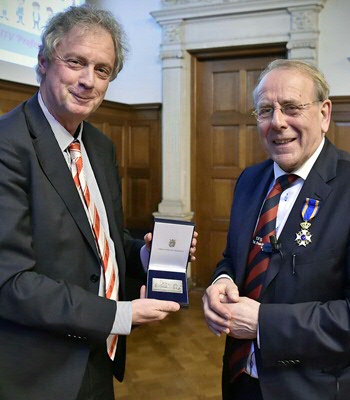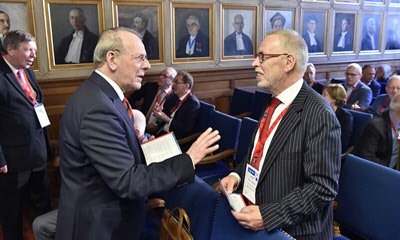Still going strong after four decades

On 29 March, the Zernike Institute of Advanced Materials held a farewell symposium in honour of Professor of Applied Physics Jeff De Hosson. De Hosson officially retired in late 2018, but he is not yet ready to say goodbye. He is full of new ideas for research and development . “29 March was the 100th birthday of Jan Francken, my predecessor”, he points out.
Text: René Fransen, photos: Elmer Spaargaren
Jeff de Hosson was appointed Professor at the University of Groningen in 1977. In his spacious office in the Physics and Chemistry building, he says, “I intended to stay for about five years. That’s what I promised my wife when I accepted the Groningen chair.” Forty-one years later, he is still there – now emeritus, but still highly active. “Over the years, there have been offers from inside and outside of Holland, but somehow I never left.” Maybe he was too busy doing what he liked best: taking fundamental physics and applying it to the real world. “I hold an MSc in theoretical physics and a PhD in theoretical materials physics, but then I wanted to apply all of this theoretical knowledge.” The technical universities in the Netherlands were then still called polytechnics, but De Hosson didn’t look there, because he considered them a different world from the classical university. “However, I discovered that Applied Physics was taught in Groningen, as an engineering discipline. This was something new!”

Vote of confidence
After his postdoc studies in the USA, he was appointed Professor of Applied Physics at the University of Groningen in 1977, only 27 years old. “At the time, these appointments were made by the Crown, and only if candidates had the support of their peers at other institutes”, De Hosson explains. “This meant that being appointed as a full professor was also a vote of confidence from your peers, and that was very helpful in getting started.” Coming from Berkeley Lab at the University of California, the new professor brought with him a lot of expertise and enthusiasm about the use of electron microscopy in materials science, quite a new technique in the 1970s. He used it to study materials at nanometre scales. He explains, “what I wanted to understand was how the properties of these materials in length and time at the atomic scale affect their performance at a macroscopic scale.”
Funding
“When I started working in Groningen, the University funded only half of a microscope. The rest of the money I had to find myself. At the time, the Dutch universities were facing cuts and reorganizations. But I had just came from the USA, where it was common practice to look for your own funds. Throughout my career, I think I may have raised some 25 million euros from external funding agencies.” In his research, De Hosson looked at defects in materials. These defects can interact and change the properties of a material, depending on their size. “Internal force fields and gradients in force fields play an important role, not only the external forces described by Isaac Newton.” One of his accomplishments was to reduce the number of sub-standard razor blades produced by the Philips electric-shaver factory in Drachten, by studying the faults in the blades. It is a well-known story, one of many in De Hosson’s long career as a scientist. “I was appointed as Professor of Applied Physics, which meant that I had to take care of the entire research programme. That was my job description, and that is what I did. So I had to have good working relations with companies, based on what I called ‘mutual esteem.’ I wasn’t only there to make breakthrough discoveries in fundamental physics, but also to bridge fundamental physics and engineering physics by devising applications.” Over the years, he worked with many companies, like Hoogovens (now Tata Steel), the car manufacturer DAF and the chemical company Akzo.

Engineering programme
He also cherished his relationship with students. Upon the retirement of his predecessor, Jan Francken, he renamed the study association for Engineering Physics “T.F.V. Professor Francken”. “In the 1970s, Francken fought hard to establish a real engineering programme at the University of Groningen. And together, we fought again in the early eighties to protect the right of our graduates to carry the title ‘nat.ir.’, the degree in engineering physics. We were successful.” Apart from his work as a lecturer and student supervisor, Jeff de Hosson made a considerable impact as a scientist. When we asked him which results make him most proud, he mentioned two: “First, we developed a method to make 3D images with electron microscopes. For a long time, this was a fundamental problem for the EM community, and our solution works on all kinds of systems. A second breakthrough is our method to deposit coatings on materials by using a laser. This required fundamental knowledge of how these coating materials behaved when you added layer by layer on top of each other.” It is 3D-printing technology avant la lettre. These types of coatings can, for example, protect car parts from corrosion, friction and wear.
Nanofoam
And De Hosson is still involved in cutting-edge science. One of his current projects is the use of metallic nanofoams. “You can create these by first producing a mixture (a ‘solid solution’) of two metals, and then etching away the less noble component.” These foams have a very large surface area. “The interaction of the surface atoms with their environment makes the foams suitable as sensitive sensors and actuators.” He is currently working with his former student Eric Detsi, now a professor at the University of Pennsylvania, on a promising application of aluminium nanofoam: “We use it to hydrolyse water and produce hydrogen ‘on site.’ We have built a toy car which runs on a fuel cell based on this nanofoam.” One of his students is now working on a scaled-up version. Another promising project is in the area of high entropy alloys. These consist of five or more elements, in roughly equal amounts. Research into these alloys has expanded in recent years. “This type of material might be used, in particular in high-temperature applications and as radiation-resistant materials in fusion reactors”, says De Hosson.
New projects
He is still deeply involved in research. The symposium in March was not quite the end of his career. “I can keep my own funding for research and for travel, as well as my office. However, I’m told I may have to downsize my big office to accommodate new research groups, and that is perfectly okay.” In May 2020, when he turns 70, his right to supervise a PhD thesis defence will expire. “My two PhD students will have to finish before then.” He still supervises a couple of undergraduate students. “But I stopped lecturing last year. And most of my research work will be outward-looking, in new projects with universities in the USA, but also, for example, in research assessment committees for other institutes around the world.” After over 1,000 papers, well over 80 PhD theses and a great many innovative ideas, things are slowly winding down. “But”, he says, “I still enjoy my work, and I am planning to continuously enjoy all the intellectual exercises in the years to come.”
More news
-
19 December 2025
Mariano Méndez receives Argentine RAÍCES award
-
18 December 2025
Why innovate, and for whom?
-
17 December 2025
Ben Feringa wins Feynman Prize
